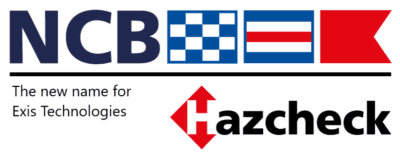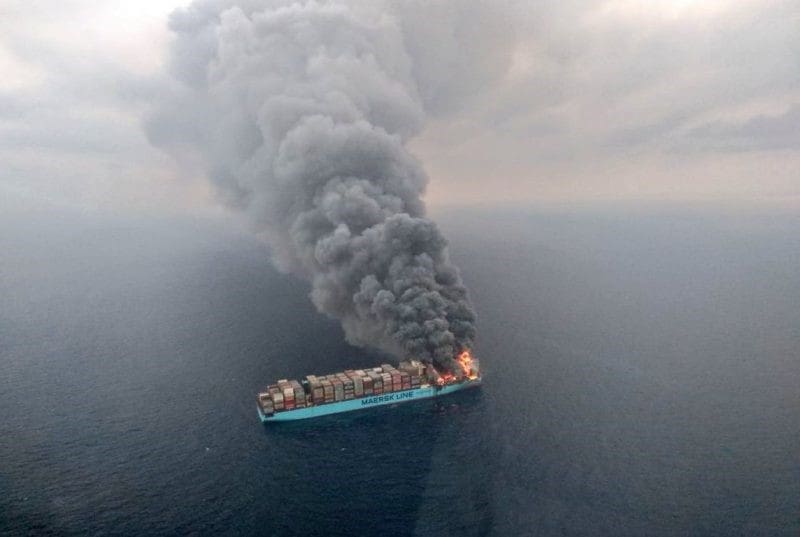Can tech tame the menace of ship fires? Freight Business Journal, December 2021
The Blockchain isn’t just about commercial efficiency. It can also play a vital role in sea safety says James Douglas, CEO of Exis Technologies
Around 60 million packed containers are moved each year, and 10 per cent are declared as dangerous goods. Some ships carry more than 1,000 containers with dangerous goods on any given voyage. With containerships getting bigger every year, the number of containers being shipped across the world continues to grow. One of the largest containership in the world at the present time, the 24,000 TEU Evergeen ship ‘Ever Ace’ can transport 23,992 twenty foot containers. With bigger and bigger ships and more containers carrying DG the potential for incidents at sea also continues to grow.
In some cases, cargo is deliberately declared incorrectly to save cost or time. In others, the cargo may have been properly declared, but mistakes are made with packing and stowing the cargo in the container. Unless the container is physically opened and inspected, there is no way of knowing whether the cargo is safe for transport. Ship fires at sea involving the carriage of dangerous goods can cause loss of life and damage to vessels, cargo and, inevitably, the environment.
The regulations
There are two international conventions produced by the International Maritime Organization (IMO), which govern the transport of all goods by sea. SOLAS the Convention for the Safety of Life at Sea dealing with the safety aspects and MARPOL the Convention for the Prevention of Pollution from Ships. All IMO Member States are required to implement national legislation to address the transport of dangerous goods, through their legal obligations under the SOLAS and MARPOL Conventions. To Assist Member States, IMO produces a detailed set of requirements covering the transport of packaged dangerous goods by sea in a separate International Maritime Dangerous Goods (IMDG) Code.
Can Blockchain help?
Blockchain is already being used in many applications far beyond crypto currency. As the shipment of dangerous goods is complex, Blockchain may be a good way to increase safety in the maritime sector. A key proposition for using Blockchain for this purpose is digital traceability of DG through the supply chain, increasing security and transparency.
In 2018, Exis took part in a Blockchain Lab initiative by the Bloc consultancy, with the support of the Lloyd’s Register Foundation, focusing on misdeclaration of dangerous goods and end-to-end traceability. Other consortium members were Agility, Port+, Flexport, Marine Transport International (MTI), SecureSystem, Copenhagen-Malmo Port (CMP), DSV, X-Press Feeders and Lloyd’s Register Group.
Dangerous goods are passed through many global players in the sea transport chain and the transport documents that go with them need to be accurate. Many systems are still paper and email based with manual extraction of data, inputted into separate systems, resulting in human error. Delays at the port can be caused by lack of information from shippers and forwarders. What is in the paperwork is not always what is in the container.
Blockchain could be used to digitise diverse DG documentation, automate transmission and updating of dangerous goods information. The supply chain could benefit from shipping delays and carrier fines, through automated transmission and updating of DG information and data to individual supply chain sectors. Increased awareness of the whereabouts of DG shipments can increase safety both ashore and at sea. Furthermore, if more goods are correctly labelled and, therefore, properly handled during shipment, this could lead to reductions in insurance premiums on the shipment and transport of dangerous goods.
Challenges
Although there appear to be many advantages to using Blockchain for this application, there are also many challenges that would need to be addressed before it was a feasible solution. All of the players in the supply chain would need to be willing and able to share their data, and data privacy and agreements on data exchange would need to be addressed.
Exis Technologies has been providing IT solutions for the shipment of DG by sea for 35 years. Hazcheck Systems are available for every link in the sea transport chain to validate declared dangerous goods against the IMDG Code, screen undeclared and misdeclared dangerous cargo to stop it from making it onto ships in the first place and to inspect containers for unsafe cargo (either in person or remotely via a mobile device).
Being able to offer Hazcheck interfaced with a Blockchain application of this nature is an interesting thought for the future. However, it would need collaborative effort from all supply chain stakeholders to make it happen.








